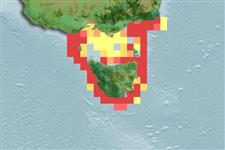Environment: milieu / climate zone / depth range / distribution range
Écologie
marin benthopélagique; non migrateur; profondeur 80 - 300 m (Ref. 1371). Temperate; 37°S - 47°S, 143°E - 152°E (Ref. 1371)
Indo-Pacific: endemic to Australia.
Taille / Poids / Âge
Maturity: Lm ? range ? - ? cm
Max length : 55.0 cm TL mâle / non sexé; (Ref. 1371)
Épines dorsales (Total) : 0; Épines anales: 0. Snout blunt, but not rounded, without a sharp rostral spine, its antero lateral margin incompletely supported by bone; chin barbel short. Head dark brown dorsally, with small pale spots. Body dark brownish with 8 or 9 pale longitudinal stripes. First dorsal fin tip black; anal fin with a blackish stripe posteriorly; the mouth and gill cavities blackish.
Generally demersal, on the continental shelf and upper slope (Ref. 9563). Feeds on octopods, fish, and decapod crustaceans.
Life cycle and mating behavior
Maturities | Reproduction | Spawnings | Egg(s) | Fecundities | Larves
Cohen, D.M., T. Inada, T. Iwamoto and N. Scialabba, 1990. FAO species catalogue. Vol. 10. Gadiform fishes of the world (Order Gadiformes). An annotated and illustrated catalogue of cods, hakes, grenadiers and other gadiform fishes known to date. FAO Fish. Synop. 125(10). Rome: FAO. 442 p. (Ref. 1371)
Statut dans la liste rouge de l'IUCN (Ref. 130435)
Menace pour l'homme
Harmless
Utilisations par l'homme
Outils
Articles particuliers
Télécharger en XML
Sources Internet
Estimates based on models
Preferred temperature (Ref.
123201): 10.9 - 14.9, mean 12.2 °C (based on 13 cells).
Phylogenetic diversity index (Ref.
82804): PD
50 = 0.5000 [Uniqueness, from 0.5 = low to 2.0 = high].
Bayesian length-weight: a=0.00251 (0.00128 - 0.00492), b=3.19 (3.03 - 3.35), in cm total length, based on LWR estimates for this Genus-body shape (Ref.
93245).
Niveau trophique (Ref.
69278): 4.1 ±0.61 se; based on food items.
Résilience (Ref.
120179): Très faible, temps minimum de doublement de population supérieur à 14 ans (Preliminary K or Fecundity.).
Fishing Vulnerability (Ref.
59153): Moderate vulnerability (42 of 100).
